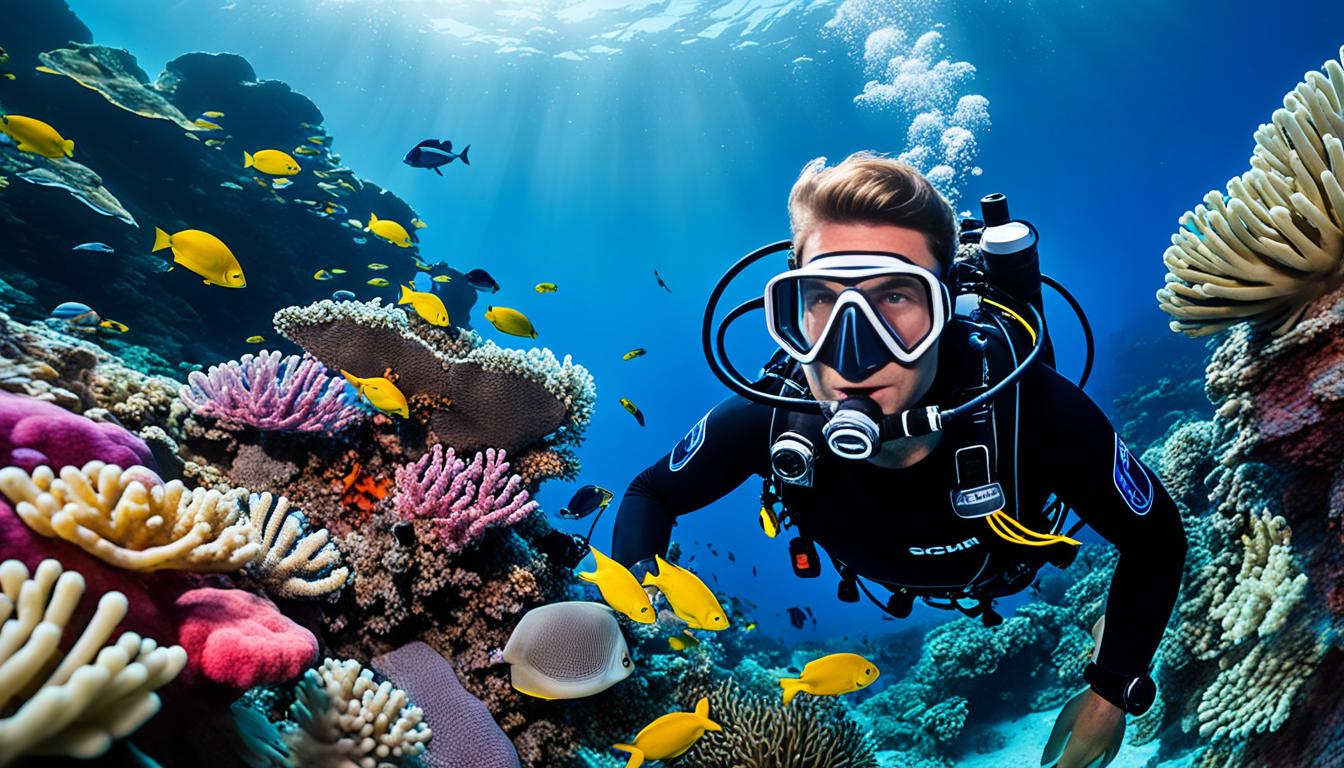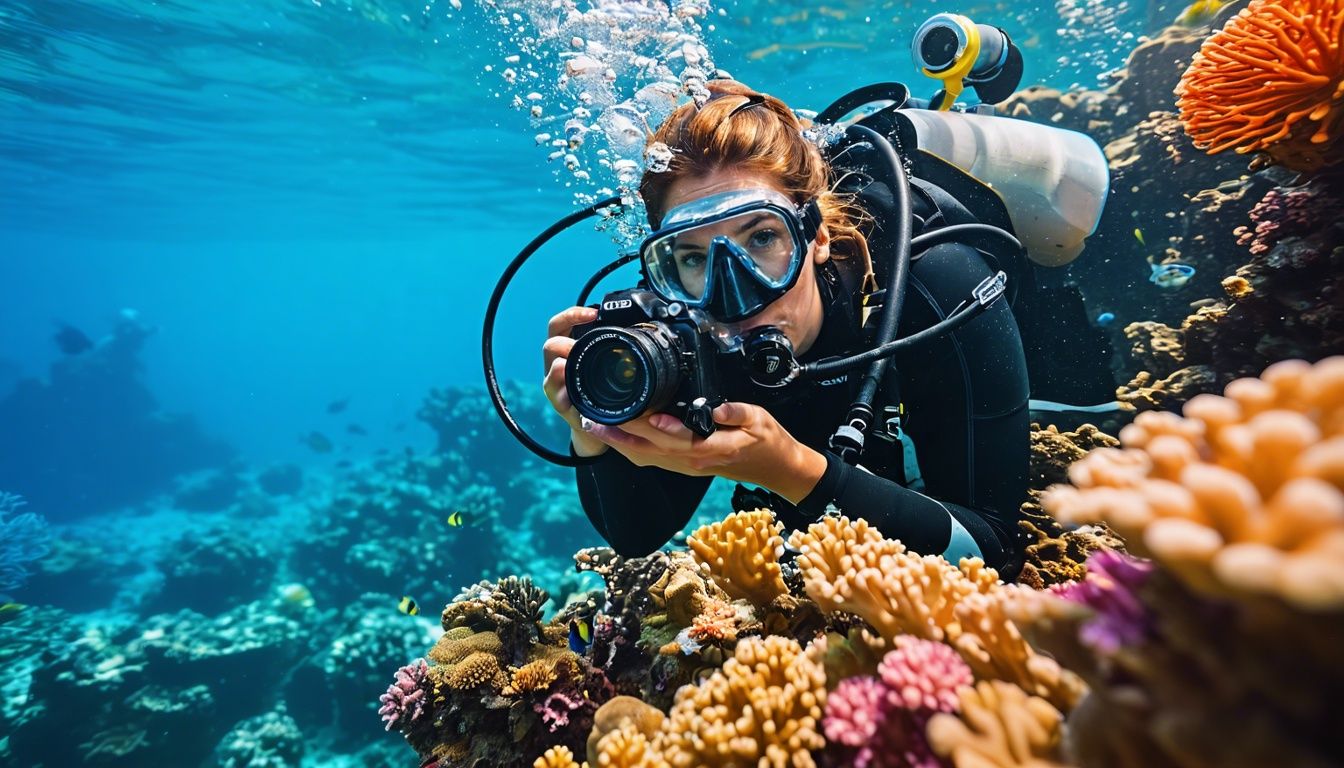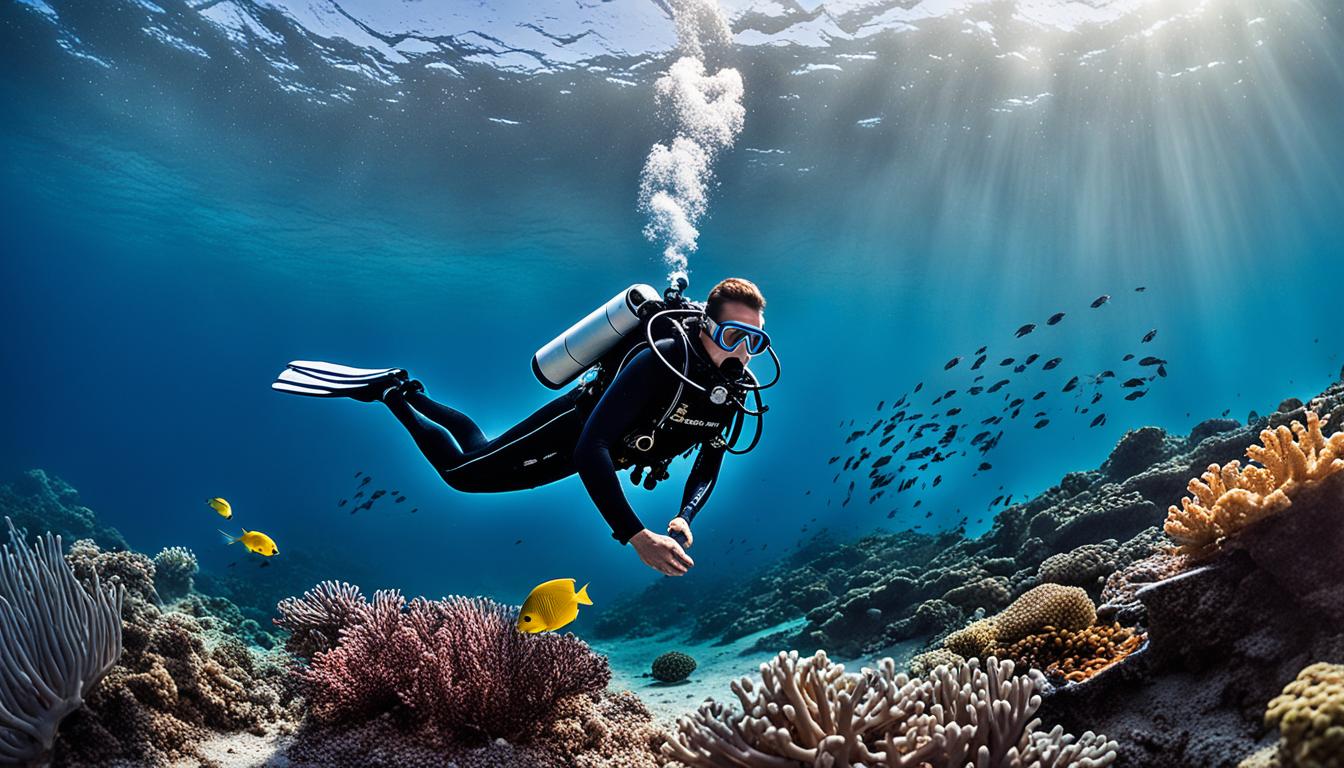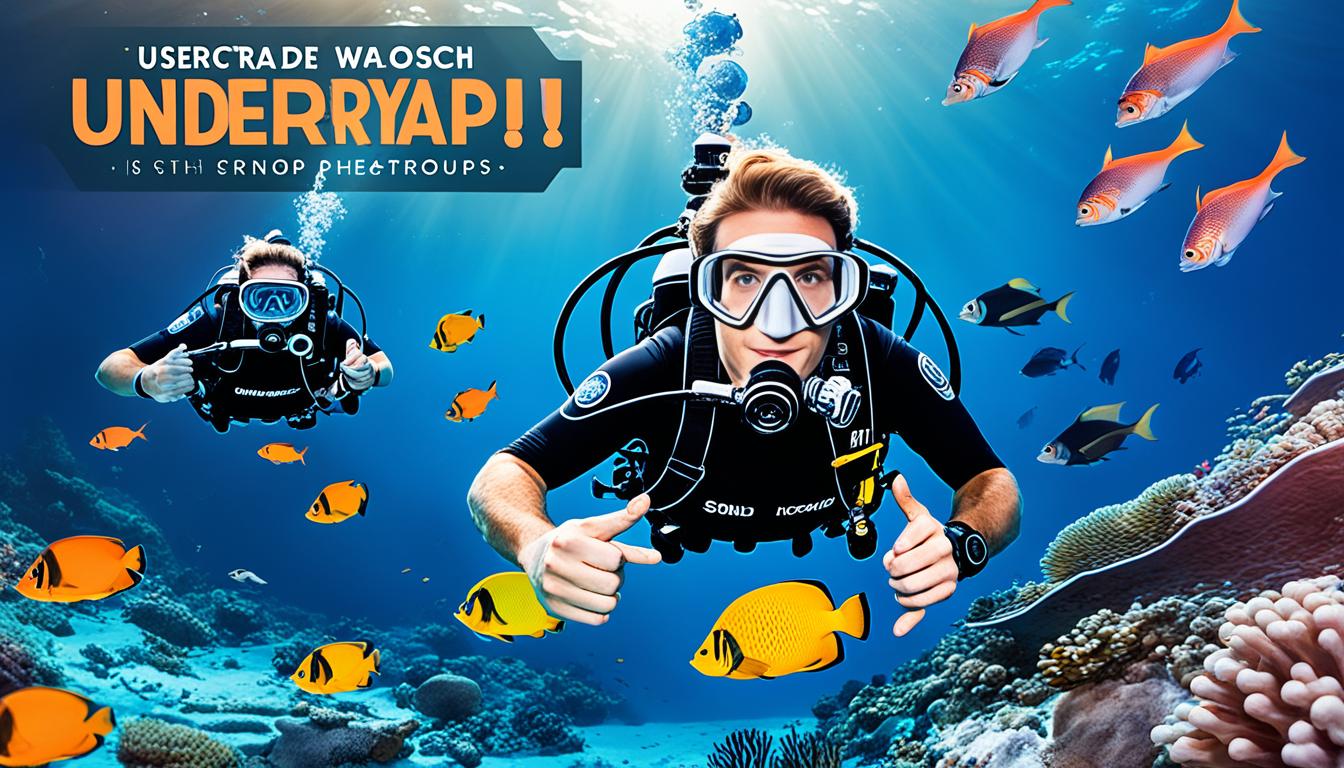Underwater photography is a thrilling and rewarding adventure that allows us to capture the wonders of the aquatic world. However, it is important to prioritize safety to ensure secure underwater adventures and stunning photography. By following diving certifications, best practices, and investing in the right camera gear, we can enjoy our underwater journeys while protecting ourselves and the marine environment.
When it comes to underwater photography safety, there are several key considerations to keep in mind. Proper diving certifications are imperative as they provide us with the necessary knowledge and skills to handle challenging underwater situations. These certifications allow us to understand diving practices, respect safety guidelines, and confidently explore the depths of the sea.
Furthermore, adhering to best practices is essential for underwater photography safety. By employing safe diving techniques, such as proper buoyancy control and efficient air consumption, we can minimize the risk of accidents and ensure a more enjoyable and secure experience. Additionally, taking necessary diving safety precautions, like planning dives within our comfort zone and having a reliable dive buddy, is crucial for our well-being underwater.
Key Takeaways:
- Obtaining diving certifications is essential for underwater photography safety.
- Adhering to best practices, such as safe diving techniques, reduces the risk of accidents.
- Taking necessary diving safety precautions contributes to a more secure underwater experience.
- Investing in the right camera gear enhances safety and the quality of underwater photography.
- Respecting the marine environment and prioritizing our safety and the safety of others is paramount.
Importance of Diving Certifications for Underwater Photography Safety
As underwater photographers, our main goal is to capture the breathtaking beauty of the underwater world. But before we dive into the depths, it’s crucial to prioritize safety. One of the key factors in ensuring a secure underwater photography experience is obtaining the right diving certifications.
Diving certifications provide you with the necessary knowledge and skills to navigate the underwater environment safely. These certifications are designed to equip you with the expertise to handle potential risks and challenges that may arise during your underwater photography adventures.
Whether you choose to pursue a basic Open Water certification or advance to specialties like Underwater Navigation or Deep Diving, each certification builds upon your understanding of safe diving practices. With the right certifications, you can confidently explore the underwater world and focus on capturing those incredible moments with your camera.
Scuba diving safety guidelines cover various aspects, including proper buoyancy control, underwater communication, emergency procedures, and dive planning. These guidelines not only enhance your safety but also ensure the protection of marine life and the fragile ecosystems you photograph.
Furthermore, diving certifications demonstrate your commitment to safety and professionalism as an underwater photographer. They provide reassurance to dive operators and fellow divers, establishing you as a responsible and knowledgeable member of the diving community.
So, before you embark on your underwater photography journey, invest in the necessary diving certifications. By doing so, you’ll not only enhance your skills and expand your diving knowledge, but also prioritize your safety and the safety of those around you.
Best Practices for Underwater Photography Safety
Ensuring your safety while practicing underwater photography is crucial for a successful and enjoyable experience. By following these best practices, you can capture stunning images while prioritizing your well-being:
1. Master Safe Diving Techniques
Before embarking on any underwater photography adventure, it’s essential to be proficient in safe diving techniques. This includes maintaining proper buoyancy control, underwater navigation skills, and effective communication with your diving partner or team. Familiarize yourself with the necessary hand signals and dive protocols to ensure a secure diving environment.
2. Perform Regular Equipment Checks
Prior to each dive, conduct thorough equipment checks to ensure everything is in proper working order. Pay close attention to your dive mask, fins, and underwater camera gear to avoid any unexpected malfunctions or leaks. Additionally, remember to secure all equipment with reliable lanyards or clips to prevent accidental loss or damage during dives.
3. Stay within Your Comfort Zone
While it’s important to push your boundaries as an underwater photographer, always prioritize your comfort and safety. Avoid attempting dives in challenging conditions or depths beyond your skill level. Gradually progress and gain experience before tackling more advanced underwater photography projects.
4. Maintain Good Diving Buddy Communication
Establish clear communication with your diving buddy or team before entering the water. This includes discussing dive plans, underwater photography objectives, and establishing hand signals for signaling distress or sharing exciting findings.
5. Respect Marine Life and the Environment
As underwater photographers, we have a responsibility to protect marine life and their natural habitats. Avoid touching or disturbing delicate corals, marine plants, or marine animals. Remember that we are guests in their underwater world, and it is our duty to preserve and respect their home.
Safety should always be a top priority when practicing underwater photography. By following safe diving techniques, regularly checking your equipment, staying within your comfort zone, maintaining good communication with your diving buddy, and respecting marine life, you can enjoy breathtaking underwater experiences while keeping yourself and the environment protected.
For further underwater photography safety tips, consult the table below:
| Underwater Photography Safety Tips | Details |
|---|---|
| Perform pre-dive safety checks | Inspect your gear, including camera housings, O-rings, and seals, to ensure they are watertight and functioning correctly. |
| Maintain a proper ascent rate | Ascend slowly and safely according to dive guidelines to prevent decompression sickness. |
| Choose the right dive site | Select dive locations suitable for underwater photography, with good visibility and minimal currents. |
| Practice good buoyancy control | Develop proper buoyancy techniques to avoid damaging marine life or disturbing underwater environments. |
| Always carry a backup dive light | A reliable backup dive light can be essential in case of unexpected low visibility or equipment failure. |
By incorporating these underwater photography safety tips into your practice, you can ensure a secure and enriching experience beneath the waves.

Recommended Underwater Camera Equipment for Safety
Investing in the right underwater camera equipment is crucial to ensure both your safety and the quality of your underwater photography. Here are some of our top recommendations:
-
Waterproof Camera Housing:
One of the most essential pieces of equipment for underwater photography is a high-quality waterproof camera housing. This protective case will safeguard your camera from water damage and allow you to capture stunning images at various depths.
-
Strobe/Flash:
Using a strobe or flash underwater is essential to bring out the vibrant colors and details in your photos, especially in deeper waters. Look for a strobe that offers adjustable power levels and fast recycle times for optimal performance.
-
Wide-angle Lens:
A wide-angle lens is perfect for capturing expansive underwater scenes and marine life. It allows you to fit more into the frame, creating visually stunning compositions. Look for a lens with a wide aperture and high-quality optics for sharp and clear images.
-
Macrophotography Lens:
If you’re interested in capturing detailed close-up shots of underwater subjects such as corals and small marine creatures, a macro lens is a must-have. Look for a lens that offers a short minimum focusing distance and excellent magnification capabilities.
-
Dive Computer:
A dive computer is an essential piece of safety equipment that not only tracks your dive profile but also provides vital information such as depth, dive time, and decompression limits. Look for a dive computer with user-friendly interfaces and accurate algorithms to enhance your diving experience.
Investing in high-quality underwater camera equipment will not only ensure your safety but also elevate the overall quality of your underwater photography. Remember to research and choose equipment that best suits your specific diving certifications and underwater photography needs.
Recommended Underwater Camera Equipment Brands
When it comes to choosing underwater camera equipment, certain brands have established themselves as leaders in the industry. Here are a few trusted brands worth considering:
- Nikon
- Canon
- Sony
- Olympus
- GoPro
- SeaLife
These brands offer a wide range of camera housings, lenses, strobes, and other accessories specifically designed for underwater photography. Make sure to explore their product offerings and consult with professionals or experts to find the best equipment for your underwater adventures.
Remember, investing in the right underwater camera equipment and obtaining essential diving certifications are both integral parts of prioritizing your safety as an underwater photographer. Let’s dive in and capture the mesmerizing beauty of the underwater world while keeping ourselves protected and our photography top-notch!
Conclusion
Underwater photography can be an incredible and rewarding experience, but safety should always be our top priority. By obtaining the necessary diving certifications, following best practices, and using the right equipment, we can ensure secure and enjoyable underwater adventures with our cameras.
When it comes to diving certifications, it’s important to undergo proper training and acquire the essential skills and knowledge. These certifications not only equip us with the necessary techniques for safe diving but also help us understand the potential risks and how to mitigate them.
In addition to diving certifications, practicing safe diving techniques is crucial. We should always adhere to diving safety precautions, such as diving within our comfort zone, maintaining proper buoyancy, and being aware of our surroundings. By doing so, we protect ourselves and minimize the chances of accidents or injuries.
Lastly, using the right equipment plays a vital role in underwater photography safety. Investing in high-quality underwater camera gear ensures reliable performance and reduces the risk of equipment failures or malfunctions. It’s essential to choose equipment that is specifically designed for underwater use and to regularly maintain and service it.
In conclusion, by obtaining diving certifications, practicing safe diving techniques, and using the right equipment, we can capture beautiful underwater images while keeping ourselves and the underwater world protected. Let’s remember to respect the marine environment, prioritize safety, and enjoy our underwater photography adventures responsibly.
FAQ
Why are diving certifications important for underwater photography safety?
Diving certifications are important for underwater photography safety because they ensure that you have the necessary skills and knowledge to dive safely. These certifications teach you how to handle potential risks and emergencies underwater, making your diving experience safer.
What are some best practices for underwater photography safety?
Some best practices for underwater photography safety include always diving with a buddy, practicing good buoyancy control to avoid damaging the marine environment, and maintaining a safe distance from marine life to prevent injuries or harm to the animals. Additionally, it’s important to stay within your training and comfort level and to plan your dive carefully.
What equipment is recommended for underwater photography safety?
To enhance your safety and the quality of your underwater photography, it is recommended to invest in a sturdy underwater camera housing that is suitable for the depth you will be diving. It’s also important to have a reliable dive computer to monitor your dive, as well as a dive torch for better visibility in low-light conditions.
What are some essential diving certifications for underwater photography safety?
Some essential diving certifications for underwater photography safety include the Open Water Diver certification, which covers the basic skills and knowledge needed for safe diving, and the Underwater Photographer specialty certification, which focuses specifically on underwater photography techniques and safety.
How can I ensure safe and enjoyable underwater adventures with my camera?
To ensure safe and enjoyable underwater adventures with your camera, it’s important to prioritize your safety and the safety of others. This can be achieved by obtaining the necessary diving certifications, following best practices, and using the recommended equipment. By respecting the marine environment and staying within your comfort zone, you can capture beautiful underwater images while keeping yourself and the underwater world protected.
How Can I Apply Safety Tips for Underwater Photography to Concert Photography?
When transitioning from underwater photography to concert photography, it’s crucial to adjust your concert photography settings and strategies for safety. Pay attention to the lighting, crowd movement, and potential obstacles. Be mindful of your surroundings and always have a plan for emergencies in place.




